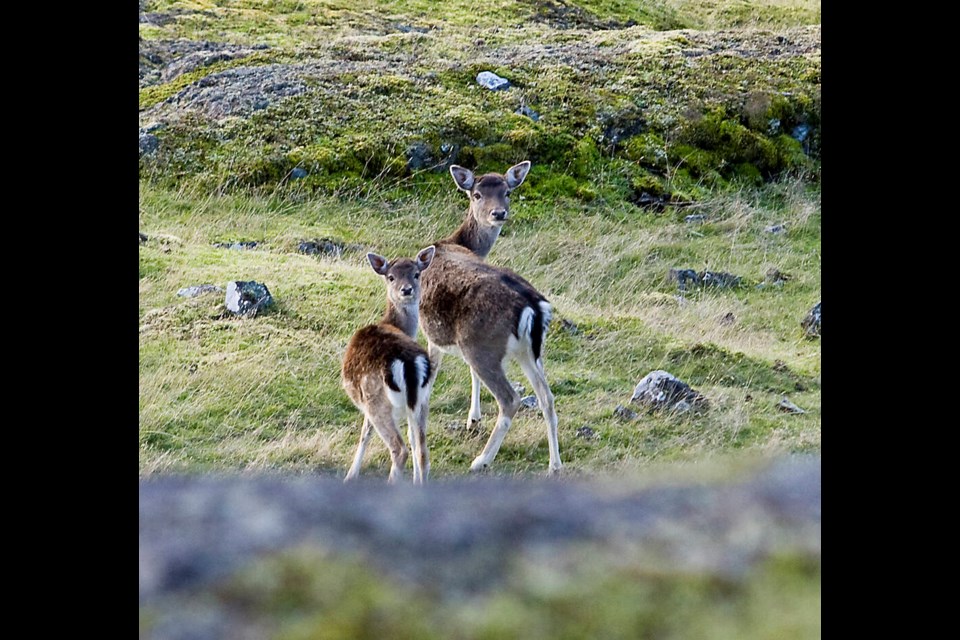Parks Canada is going ahead with a mass roundup and kill of European fallow deer on Sidney Island after property owners on the island narrowly approved it.
Starting in the late fall, a contracted company will use two expert marksmen in a helicopter and another two on the ground to “dispatch” as many of the fallow deer as possible, Molly Clarkson, superintendent of the Gulf Islands National Park Reserve, said in an interview Friday.
The 10-day hunt will be followed by a year-long pause to assess if there are any survivors. A mop-up operation will follow using fencing and trained tracker dogs to flush out, contain and shoot any remaining fallow deer.
Controlled hunting and periodic culls over the years have reduced the number of fallow deer on the island from thousands in the 1980s to an estimated 400 to 500.
The cull, which will be undertaken by a company called Coastal Conservation, is part of a $5.9-million contract that will also see native plants species restored on Sidney Island. The goal is to eventually restore the endangered Garry oak and Douglas fir ecosystems that have been ravaged by the fallow deer and overrun by invasive plants like English hawthorn and Scotch broom.
The cull and continued management of the black-tailed deer population represents the majority of the overall contract, about $4.5 million, according to Parks Canada.
The decision to move forward with the cull came Friday following a narrow 52% vote in favour by the Sallas Forest Strata Corp. A total of 99 votes were cast.
The Sidney Island property owners, who own 1,500 hectares in 111 bare-land-strata lots, had the final say on whether the cull would go ahead. It has long been a sensitive subject among owners, who were split between favouring a mass kill and continuing to reduce the numbers of deer though seasonal hunting.
Parks Canada controls about 440 hectares on the north end of the island — including Sidney Spit — as part of Gulf Islands National Park Reserve. It’s leading the restoration initiative with the First Nations of the W̱SÁNEĆ Leadership Council, Pauquachin First Nation, the province, Islands Trust Conservancy and strata residents.
Eric Pelkey, hereditary chief of the Tsawout Nation and representative of the W̱SÁNEĆ Leadership Council, said Friday that ridding Sidney Island of the destructive fallow deer “is a great occasion for our people.”
European fallow deer were introduced on neighbouring James Island in 1902 as prey for hunting parties. The spotted deer with large antlers invaded Sidney Island in the early 1960s, when ponds were dug and the first standing fresh water became available to sustain them.
Their numbers grew to the thousands in the 1980s, damaging Garry oak meadows, Douglas firs and dozens of native plant species, including “medicine plants” beneficial to First Nations, said Pelkey.
“We have to correct the ecological imbalances on the island,” said Pelkey. “Our people have been going out and looking for medicines, but they can no longer be found … the fallow deer take everything.”
First Nations want to see Sidney Island return to the natural state when their ancestors had an active village and burial grounds there. Pelkey said edible and medicinal plants such as camas and ferns were plentiful and native black-tailed deer caused far less damage.
Clarkson said Sidney Island is considered one of the least ecologically diverse islands in the Gulf Islands because of the deer and invasive plants.
She said an assessment process outlining all aspects of the restoration and cull will be open for the public to view and comment on prior to the fallow deer hunt, on the Impact Assessment Agency of Canada website at iaac-aeic.gc.ca.
Measures to ensure public safety will be in place during the hunt and cull, said Clarkson. The hunters will be using high-powered rifles.
Clarkson said representatives of the B.C. SPCA will be present as observers during the eradication on the ground. “We have been working closely with the animal-care community to ensure that plans are focused on causing as little stress as possible [on the fallow deer],” she said.
Pelkey said First Nations will take part in harvesting the fallow deer for meat and hides.
Michael Law, spokesman for the strata owners on Sidney Island who ultimately gave the green light on the cull, said killing the fallow deer was a “necessary first step” to remove an invasive species that is causing significant damage to the ecosystem.
He said while Sidney Island strata owners had different visions on restoring balance, “the goal of all involved was to do what’s in the best interest of the island.”
“The close vote indicates how carefully everyone was thinking about it,” said Law. “I don’t see it as dividing the community. It’s tight knit.”
Coastal Conservation has been involved in deer culls before. In 2017, it was part of a plan on Haida Gwaii to eradicate Sitka black-tailed deer, which were introduced there for hunting in 1898.
The federal government spent $5.7 million on the program, as it fell within Gwaii Haanas National Park Reserve.
In 2017, a total of 598 deer were shot from March to October and their meat was distributed for food on Haida Gwaii. Hunters fired rifles from low-flying helicopters and from the ground with tracking dogs. Shooting also took place from boats along the shoreline.
— with a file from the Vancouver Sun
>>> To comment on this article, write a letter to the editor: [email protected]




